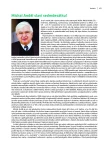-
Medical journals
- Career
Congenital hyperinsulinism: Loss of B-cell self-control
Authors: Jan Lebl; Klára Roženková; Štěpánka Průhová
Authors‘ workplace: Pediatrická klinika 2. LF UK a FN v Motole, Praha
Published in: Vnitř Lék 2016; 62(Suppl 4): 72-76
Category: Reviews
Overview
Congenital hyperinsulinism is a serious blood glucose regulation defect that interferes with brain development, leading to mental retardation, neurological sequelae and secondary epilepsy and ultimately may be life-threatening. Congenital hyperinsulinism (CHI) is caused by genetic defects of regulation of insulin secretion that induce insulin oversecretion in intrauterine life and postnatally. The clinical consequence is fetal macrosomia and subsequently neonatal and infantile hypoglycaemia. The most severe form is caused by biallelic mutations of KCNJ11 and ABCC8 genes that encode both potassium channel subunits, whereas their heterozygous mutations as well as enzymatic defects (GLUD1, HADH, GCK) lead to milder presentation. HNF4A or HNF1A transcriptional factor defects lead to transient hyperinsulinism but to MODY diabetes later in life, due to biphasic beta-cell dysfunction starting as hyperfunction and developing via normal function to hypofunction. An early aetiological diagnosis and effective treatment of congenital hyperinsulinism substantially improves the outcome regarding not only survival but also neurocognitive functions.
Key words:
B-cell – congenital hyperinsulinism (CHI) – hypoglycaemia – insulin
Sources
1. Dunne MJ, Cosgrove KE, Shepherd RM et al. Hyperinsulinism in infancy: from basic science to clinical disease. Physiol Rev 2004; 84(1): 239–275.
2. Menni F, Lonlay P de, Sevin C et al. Neurologic outcomes of 90 neonates and infants with persistent hyperinsulinemic hypoglycemia. Pediatrics 2001; 107(3): 476–479.
3. Aynsley-Green A, Hussain K, Hall J et al. Practical management of hyperinsulinism in infancy. Arch Dis Child Fetal Neonatal Ed 2000; 82: F98-F107.
4. Matschinsky FM. Regulation of pancreatic beta-cell glucokinase: from basics to therapeutics. Diabetes 2002; 51(Suppl 3): S394-S404.
5. Roženková K, Güemes M, Shah P et al. The Diagnosis and Management of Hyperinsulinaemic Hypoglycaemia. J Clin Res Pediatr Endocrinol 2015; 7(2): 86–97. Dostupné z DOI: <http://dx.doi.org/10.4274/jcrpe.1891>.
6. Arnoux JB, Verkarre V, Saint-Martin C et al. Congenital hyperinsulinism: current trends in diagnosis and therapy. Orphanet J Rare Dis 2011; 6 : 63. Dostupné z DOI: <http://dx.doi.org/10.1186/1750–1172–6-63>.
7. Nessa A, Rahman SA, Hussain K. Hyperinsulinemic Hypoglycemia – The Molecular Mechanisms. Front Endocrinol (Lausanne) 2016; 7 : 29. Dostupné z DOI: <http://dx.doi.org/10.3389/fendo.2016.00029>.
8. Charlotte Kane RMS, Squires PE, Johnson PR et al. Loss of functional KATP channels in pancreatic B-cells causes persistent hyperinsulinemic hypoglycemia of infancy. Nat Med 1996; 2(12): 1344–1347.
9. Rozenkova K, Malikova J, Nessa A at al. Incidence of Heterozygous ABCC8 and HNF1A Mutations in Czech Patients With Congenital Hyperinsulinism. J Clin Endocrinol Metab 2015; 100(12): E1540-E1549. Dostupné z DOI: <http://dx.doi.org/10.1210/jc.2015–2763>.
10. Dusátková P, Průhová S, Sumník Z et al. HNF1A mutation presenting with fetal macrosomia and hypoglycemia in childhood prior to onset of overt diabetes. J Pediatr Endocrinol Metab 2011; 24(5–6): 377–379.
11. Otonkoski T, Näntö-Salonen K, Seppänen M et al. Noninvasive diagnosis of focal hyperinsulinism of infancy with [18F]-DOPA positron emission tomography. Diabetes 2006; 55(1): 13–18.
12. Bax KN, van der Zee DC. The laparoscopic approach toward hyperinsulinism in children. Semin Pediatr Surg 2007; 16(4): 245–251.
13. Fékété CN, de Lonlay P, Jaubert F et al. The surgical management of congenital hyperinsulinemic hypoglycemia in infancy. J Pediatr Surg 2004; 39(3): 267–269.
14. Munns CF, Batch JA. Hyperinsulinism and Beckwith-Wiedemann syndrome. Arch Dis Child Fetal Neonatal Ed 2001; 84(1): 67–69.
Labels
Diabetology Endocrinology Internal medicine
Article was published inInternal Medicine

2016 Issue Suppl 4-
All articles in this issue
- Adaptation of adipose tissue to weight-reduction energy-restricted diet in obese individuals
- Heterogeneity of childhood diabetes and its therapeutic implications
- History of diagnosis and therapy of diabetic retinopathy
- Metabolic syndrome in patients with diabetes mellitus type 1, prevalence, impact on morbidity and mortality
- Frequency and timing of meals and changes in body mass index: Analysis of the data from the Adventist Health Study-2
- Education of a patient with diabetes – an integral part of complex therapy
- Pregestional diabetes mellitus and pregnancy
- Bariatric surgeries at diabetic patients
- Mind as an immunomodulator
- Diabetic foot syndrome from the perspective of internist educated in podiatry
- OxLDL/β2-glycoprotein I complex as a pro-atherogenic autoantigen. Is atherosclerosis an autoimmune disease?
- Gestational Diabetes Mellitus
- Growth hormone, axis GH-IGF1 and glucose metabolism
- Promising molecules for treatment of hyperglycemia in patients with type 2 diabetes
- Congenital hyperinsulinism: Loss of B-cell self-control
- Obstructive sleep apnoea and type 2 diabetes mellitus
- Short-term and long-term glycemic variability and its relationship to microvascular complications of diabetes
- Composition of macronutrients in the diabetic diet
- Is glucosis only basic energy substrate?
- Actual trends in diagnostics and treatment of congenital hyperinsulinism
- Should we consider a new classification of diabetes influenced by therapeutic decisions?
- Diabetes mellitus in older adults from the point of view of the clinical diabetologist
- Internal Medicine
- Journal archive
- Current issue
- Online only
- About the journal
Most read in this issue- Congenital hyperinsulinism: Loss of B-cell self-control
- Gestational Diabetes Mellitus
- Growth hormone, axis GH-IGF1 and glucose metabolism
- Education of a patient with diabetes – an integral part of complex therapy
Login#ADS_BOTTOM_SCRIPTS#Forgotten passwordEnter the email address that you registered with. We will send you instructions on how to set a new password.
- Career

